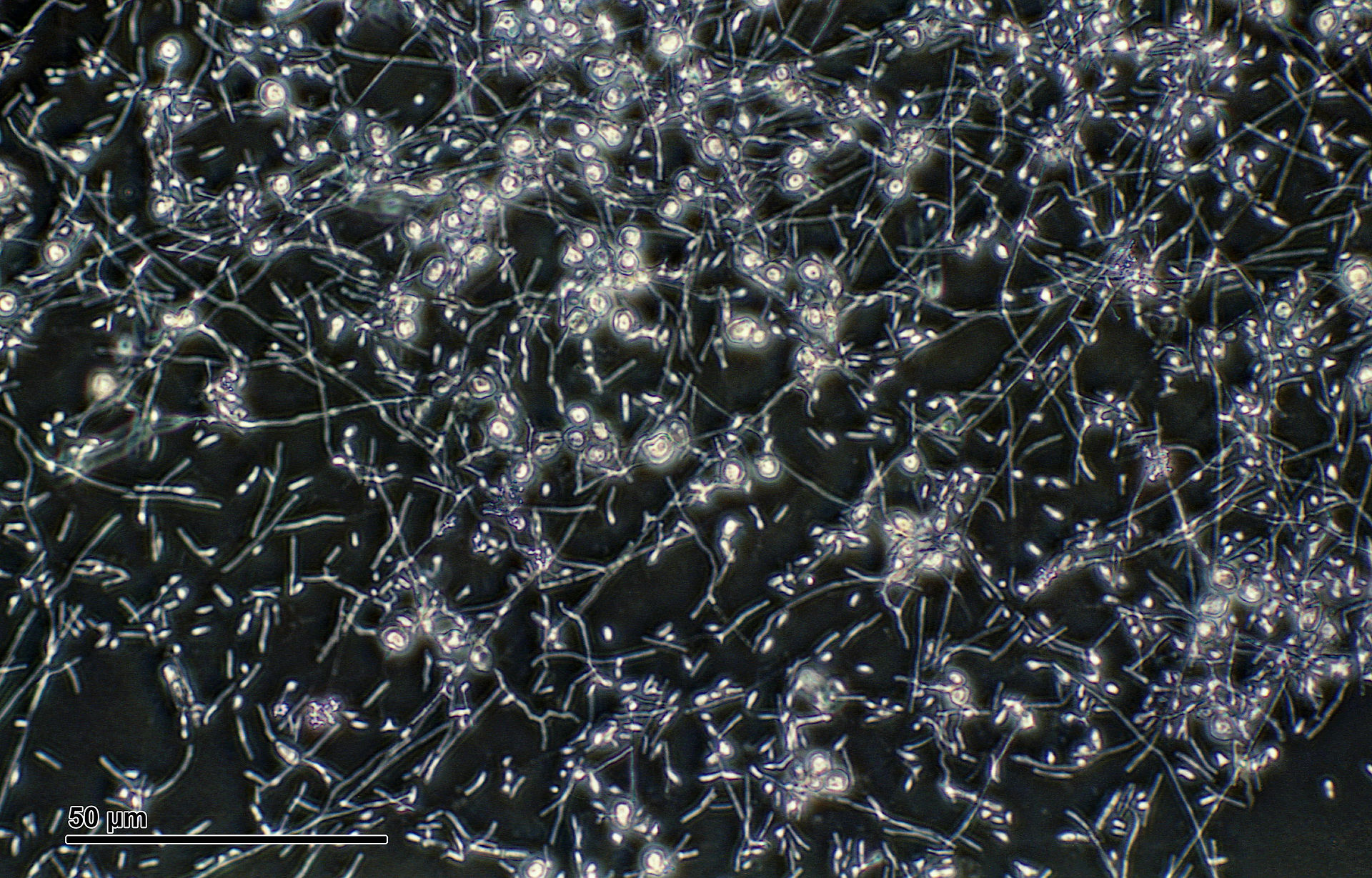Trichophyton interdigitale: Difference between revisions
Jump to navigation
Jump to search
(Created page with "{{Taxobox | image = Trichophyton mentagrophytes (257 18) Cultured.jpg | image_caption = ''Trichophyton mentagrophytes'' | regnum = Fungi | divisio = Ascomycota...") |
No edit summary |
||
| Line 1: | Line 1: | ||
{{Taxobox | {{Taxobox | ||
| image = | | image = Trichophyton_mentagrophytes1.jpg | ||
| image_caption = ''Trichophyton mentagrophytes'' | | image_caption = ''Trichophyton mentagrophytes'' | ||
| regnum = [[Fungus|Fungi]] | | regnum = [[Fungus|Fungi]] | ||
| Line 13: | Line 13: | ||
}} | }} | ||
[[File:Trichophyton mentagrophytes (257 19) From a microculture and an infected hair.jpg|thumb|''Trichophyton mentagrophytes'' on a hair]] | [[File:Trichophyton mentagrophytes (257 19) From a microculture and an infected hair.jpg|thumb|''Trichophyton mentagrophytes'' on a hair]] | ||
'''''Trichophyton interdigitale''''' is a species of ''[[Trichophyton]]''.<ref name=Kawasaki2008/> It can produce [[penicillin]]. | '''''Trichophyton interdigitale''''' is a species of ''[[Trichophyton]]''.<ref name=Kawasaki2008>{{cite journal |author=Kawasaki M, Anzawa K, Wakasa A, ''et al.'' |title=Different genes can result in different phylogenetic relationships in trichophyton species |journal=Nippon Ishinkin Gakkai Zasshi |volume=49 |issue=4 |pages=311–8 |year=2008 |pmid=19001759 |url=http://joi.jlc.jst.go.jp/JST.JSTAGE/jjmm/49.311?lang=en&from=PubMed |accessdate=2011-01-24}}</ref> It can produce [[penicillin]]. | ||
Some sources equate it with "Trichophyton mentagrophytes".<ref name=Zaias2003/> As such is one of three common fungi which cause [[ringworm]] in companion animals. It is also the second most commonly isolated fungus causing so-called [[tinea]] infections in humans, and the most common or one of the most common fungi that causes [[zoonotic]] skin disease (i.e., transmission of [[mycotic]] skin disease from species to species. The fungus has a major natural reservoir in rodents, but can also infect pet rabbits, dogs and horses. | Some sources equate it with "Trichophyton mentagrophytes".<ref name=Zaias2003>{{cite journal |author=Zaias N, Rebell G. |title=Clinical and mycological status of the ''Trichophyton mentagrophytes'' (interdigitale) syndrome of chronic dermatophytosis of the skin and nails |journal=Int. J. Dermatol. |volume=42 |issue=10 |pages=779–88 |year=2003 |pmid=14521690 |url=http://onlinelibrary.wiley.com/resolve/openurl?genre=article&sid=nlm:pubmed&issn=0011-9059&date=2003&volume=42&issue=10&spage=779 |accessdate=2011-01-24| doi = 10.1046/j.1365-4362.2003.01783.x}}</ref> As such is one of three common fungi which cause [[ringworm]] in companion animals. It is also the second most commonly isolated fungus causing so-called [[tinea]] infections in humans, and the most common or one of the most common fungi that causes [[zoonotic]] skin disease (i.e., transmission of [[mycotic]] skin disease from species to species. The fungus has a major natural reservoir in rodents, but can also infect pet rabbits, dogs and horses. | ||
==References== | ==References== | ||
Revision as of 13:57, 10 August 2015
| style="background:#Template:Taxobox colour;"|Template:Taxobox name | ||||||||||||||
|---|---|---|---|---|---|---|---|---|---|---|---|---|---|---|
 Trichophyton mentagrophytes
| ||||||||||||||
| style="background:#Template:Taxobox colour;" | Scientific classification | ||||||||||||||
| ||||||||||||||
| Binomial name | ||||||||||||||
| Trichophyton interdigitale Priestley (1917) |
Trichophyton interdigitale is a species of Trichophyton.[1] It can produce penicillin.
Some sources equate it with "Trichophyton mentagrophytes".[2] As such is one of three common fungi which cause ringworm in companion animals. It is also the second most commonly isolated fungus causing so-called tinea infections in humans, and the most common or one of the most common fungi that causes zoonotic skin disease (i.e., transmission of mycotic skin disease from species to species. The fungus has a major natural reservoir in rodents, but can also infect pet rabbits, dogs and horses.
References
- ↑ Kawasaki M, Anzawa K, Wakasa A; et al. (2008). "Different genes can result in different phylogenetic relationships in trichophyton species". Nippon Ishinkin Gakkai Zasshi. 49 (4): 311–8. PMID 19001759. Retrieved 2011-01-24.
- ↑ Zaias N, Rebell G. (2003). "Clinical and mycological status of the Trichophyton mentagrophytes (interdigitale) syndrome of chronic dermatophytosis of the skin and nails". Int. J. Dermatol. 42 (10): 779–88. doi:10.1046/j.1365-4362.2003.01783.x. PMID 14521690. Retrieved 2011-01-24.